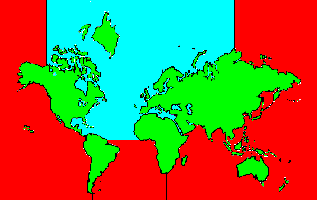SPECIES INFO
Great Frigate Bird (Fregata minor) is found along the coasts and islands of the Pacific Ocean including the Hawaiian Islands. It is sometimes found in the southern Atlantic Ocean and the Indian Ocean. This large bird stands forty inches tall and has a wingspan of seven feet. In flight, the angled wings and forked tail help identify this large dark bird.
The young birds can show a yellow head. The males are generally very dark. However, the males of both the Great and Lesser Frigate bird can sometimes show a red throat sack. The females have a white middle and upper breast.
There are 5 subspecies. The nominate subspecies is found in the Indian Ocean and also in the South China Sea. The subspecies palmerstoni breeds in the western and central Pacific Ocean. The subspecies ridgwayi breeds in the eastern Pacific both near Mexico and in the Galapagos. The subspecies nicolli is found in the south Atlantic. The subspecies aldabrensis can be found in the western Indian Ocean including Aldabra Islands.Frigatebird genus (Fregata) contains 5 species of large oceanic birds. These birds are large with long bills. The necks are short and the wings are long and pointed. The long tails are forked. These birds obtain much of their food by chasing other seabirds.
Although many large seabirds fly with bent wings, the frigate birds seem to have very sharp bends in the middle of their wings when in flgiht.
These birds are usually found near land, as they return to land to spend the night. When at sea they can fly at great heights.
Frigate Birds (Family Fregatidae) are found flying over the tropical seas of the world. These birds have enormous wings that support a relatively small body. Consequently, they are among the best flyers of the species of birds that are found over the oceans.
Pelicans and Allies (Order Pelecaniformes) contains six different families of marine birds. Most are large species and
most feed on fish. One distinguishing feature of this order is the webbing that connects all four toes.
Aves contains about 8,650 different species of living birds known to science. Each year about one new species is discovered in some remote rain forest or remote island. In addition, scientists have been raising many subspecies to full species status which may raise the species count to 10,000. Birdlife recognizes 10,027 species as of 2011.
However, each year about one species goes extinct. The rate of extinction is increasing, and the rate of new discovery is decreasing, so that the number of bird species will soon begin to decline rapidly. Although different taxonomists would organize the birds differently, there are approximately twenty-seven orders of birds. These orders are broken down into about one hundred and fifty-five different families.
Recent research of the genetic structure of some of the shore birds and owls would indicate that the present organization of orders and families should have some modification.
The birds are a worldwide group of animals that are characterized by having the front limbs modified into wings that are used for flying. Perhaps the most unique feature of the birds is the feathers. These feathers are made up of a central support called a quill and a series of small filaments that are hooked together as barbs.
For many years it was believed that Archaeopteryx discovered in Bavaria was the oldest bird from about 150 million years ago. However, in l986, Sankar Chattterjee, a Texas paleontologist, reportedly discovered a bird in the genus Protoavis that lived about 225 million years ago.
When this project was begun in 1978, we used Austin & Singer for bird taxonomy. Since then, we have adopted many changes, but have kept some older concepts that are still found widely in the literature. Recently, we have used Clements and Howard & Moore. Very recently, we have used Monroe and Sibley for the higher taxonomy of the perching birds.
Backboned Animals (Phylum Chordata) are the most advanced group of animals on earth. These animals are characterized by having a spinal cord or backbone. Most members have a clearly defined brain that controls the organism through a spinal cord. Fish, amphibians, reptiles, birds, and mammals are in this phylum.
Currently, some taxonomists believe that the fish should be divided into two groups (sharks and regular fishes) and that there are some other primitive groups in the phylum such as hagfish or lampreys.
Animal Kingdom contains numerous organisms that feed on other animals or plants. Included in the animal kingdom are the lower marine invertebrates such as sponges and corals, the jointed legged animals such as insects and spiders, and the backboned animals such as fish, amphibians, reptiles, birds, and mammals.


